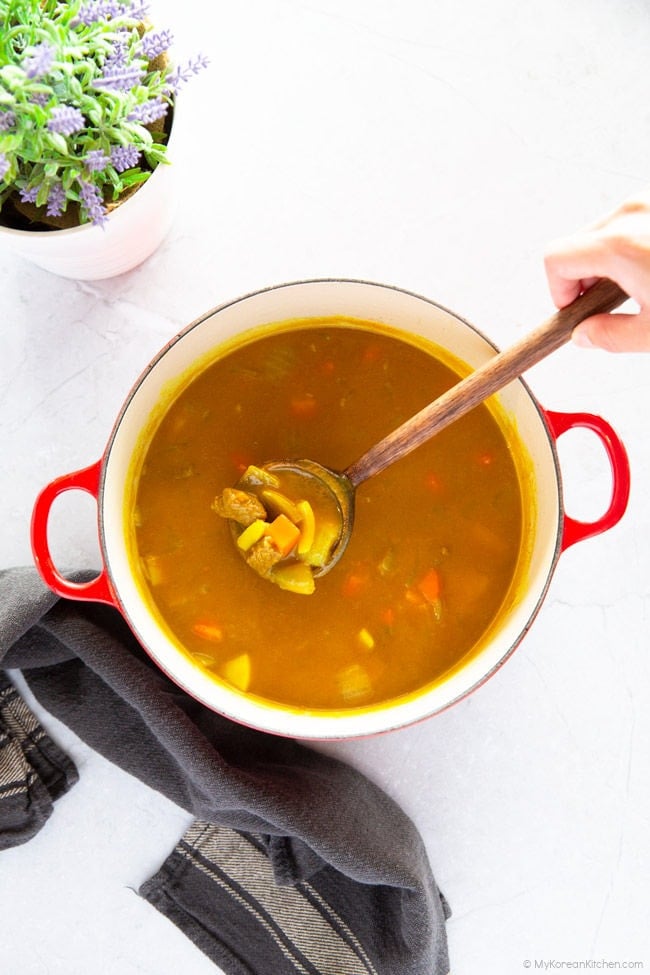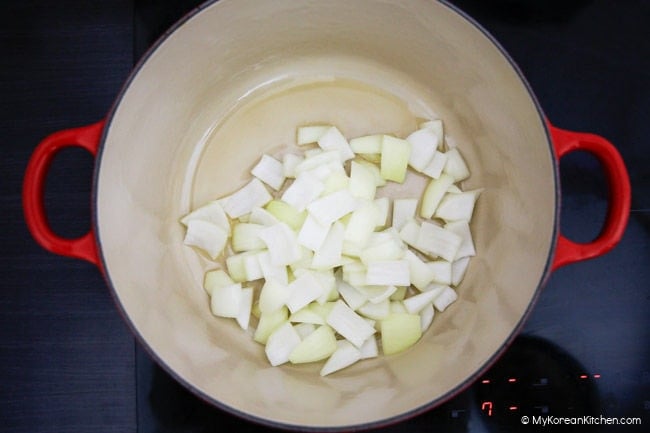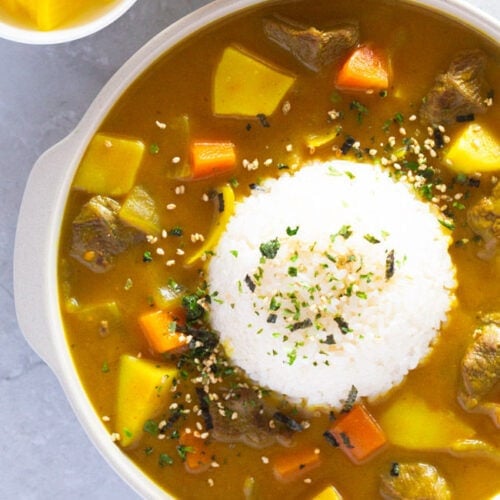Learn how to make Korean curry rice at home! Packed with savory, slightly sweet, and mildly spicy flavors, this comforting dish is perfect for easy weeknight dinners.

What is Korean Curry Rice
Korean curry rice is a simple, versatile, and satisfying dish, making it a staple in many Korean households, particularly those with children. Growing up in Korea, I would have it at least once a week, whether at home or in the school cafeteria. It’s pronounced ‘Kare Raisu / Raiseu (카레 라이스)’ in Korean, echoing the sound of ‘Japanese curry rice’. Indeed, this dish was introduced from Japan.
The flavor profile of Korean curry is unique, with a slightly sweet, mildly spicy, and savory taste. It is similar to Japanese curry but distinct from Indian or Thai curry. Whether you prefer a vegetable heavy curry or a meaty one, this dish can easily accommodate your preferences.
How I Make My Curry
To make Korean curry rice, you start with your choice of small diced cut of meat—be it pork, beef, or chicken—and cook it over the stove until lightly brown. Then combine them with a variety of fresh vegetables like potatoes, onions, and carrots. This hearty mix is then simmered in water until tender, and then combined with a rich and aromatic Korean curry sauce, creating a dish that’s flavorful, comforting and satisfying.
I would like to point out that pork is typically used in Korean curry, but beef or chicken is popular as well.
In fact, I have a preference for using stew friendly diced beef in my curry rice. I find that beef has a less gamey smell compared to pork, and stew-friendly cuts are ideal for simmering in order to allow the meat to release all of its robust, savory goodness into the curry sauce. If you’re using lean meat, it’s important not to overcook it as it can become dry.
I also like to add some butter to subtly enhance the flavors and reduce the spice level for my family, even though the curry itself isn’t particularly spicy. This addition not only imparts a delightful buttery taste but also offers a unique twist. It’s worth noting that this is not a common practice among Koreans, who typically enjoy their curry as is.
Once everything is cooked to perfection, the curry is ladled over a bed of fluffy, steamed rice. Each mouthful is a delightful blend of flavors – the sweet undertones of the onions and carrots, the savory depth of the meat, all perfectly balanced by the delicately spicy, umami-rich curry.

Instant Korean Curry
Now, let’s talk about the highlight ingredient of Korean curry rice — the instant curry mix. Many Koreans use this mix because it offers a convenient way to achieve a rich and complex curry flavor without having to spend hours in the kitchen making it. In fact, I have yet to meet any Koreans who would blend their own Korean curry powder from scratch at home. The mix is also inexpensive, which gives you even more reason to try it!
There are several brands of instant Korean curry available at Korean grocers, whether in powder format or pre-made roux format. Each brand offers different spice levels, making it easy to find one that suits your taste buds.
So, whether you’re scrambling for a quick dinner solution on a hectic weeknight or planning a casual meal with your family, Korean curry rice won’t let you down!

Ingredients for Korean Curry Rice
- 250g / 8.8 ounce beef chuck steak (or your choice of meat), diced
- 1 Tbsp sweet rice wine (mirin)
- 3/4 cup water, to mix with the curry powder
- 100g / 3.5 ounce Korean curry powder
- 2 Tbsp cooking oil
- 200g / 7 ounce onion, peeled and cut into large cubes
- 70g / 2.5 ounce salted butter
- 150g / 5.3 ounce potato, peeled and cut into large cubes
- 120g / 4.2 ounce carrot, peeled and cut into large cubes
- 4 cups water
- Steamed rice, to serve
* 1 Tbsp = 15 ml, 1 cup = 250 ml
How To Make Korean Curry
1. In a bowl, marinate the meat with sweet rice wine (mirin), then set it aside for 5 minutes.

2. In a small jug, combine 3/4 cup of water with the Korean curry powder. Mix well until you achieve a smooth, well-blended mixture.

3. Preheat a large pot (e.g. dutch oven) over medium-high heat. Then, add the cooking oil and sauté the onions until they turn golden brown.

4. Add the previously marinated meat to the pot and stir. Cook the meat until it reaches a medium level of doneness, with a slight hint of pink in the center.

5. Add the butter to the pot and stir until it completely melts and evenly incorporates into the dish.

6. Add the potato and carrot pieces to the pot, and then pour in 4 cups of water.

7. Bring the pot to a boil over medium-high heat. Continue cooking uncovered for about 30 minutes, periodically skimming off any bubbles or foam that may form on the surface and discarding them. Stir occasionally to prevent sticking.

8. Finally, add the prepared curry powder mixture to the pot and stir it in until the curry thickens, which should take around 1 minute.

9. Serve the curry on a bed of steamed rice with a variety of side dishes to complement the flavors. Some popular side dishes include kimchi, radish kimchi, pickled radish, and a refreshing pickled cucumber. You can store any leftover curry in an airtight container in the refrigerator for 3 to 4 days, or freeze it for up to 3 months.


Love Korean food? Browse even more delicious ideas from my collection of easy Korean recipes. Don’t forget to subscribe to my newsletter to stay updated on new recipes, what the MKK community is cooking, and K-Dramas!

Korean Curry Rice
Ingredients
- 250 g beef chuck steak (or your choice of meat), (8.8 ounce), diced
- 1 Tbsp sweet rice wine (mirin)
- 3/4 cup water , to mix with the curry powder
- 100 g Korean curry powder (3.5 ounce)
- 2 Tbsp cooking oil
- 200 g onion (7 ounce), peeled and cut into large cubes
- 70 g salted butter (2.5 ounce)
- 150 g potato (5.3 ounce), peeled and cut into large cubes
- 120 g carrot (4.2 ounce), peeled and cut into large cubes
- 4 cups water
- steamed rice , to serve
Instructions
- In a bowl, marinate the meat with sweet rice wine (mirin), then set it aside for 5 minutes.
- In a small jug, combine 3/4 cup of water with the Korean curry powder. Mix well until you achieve a smooth, well-blended mixture.
- Preheat a large pot (e.g. dutch oven) over medium-high heat. Then, add the cooking oil and sauté the onions until they turn golden brown.
- Add the previously marinated meat to the pot and stir. Cook the meat until it reaches a medium level of doneness, with a slight hint of pink in the center.
- Add the butter to the pot and stir until it completely melts and evenly incorporates into the dish.
- Add the potato and carrot pieces to the pot, and then pour in 4 cups of water.
- Bring the pot to a boil over medium-high heat. Continue cooking uncovered for about 30 minutes, periodically skimming off any bubbles or foam that may form on the surface and discarding them. Stir occasionally to prevent sticking.
- Finally, add the prepared curry powder mixture to the pot and stir it in until the curry thickens, which should take around 1 minute.
- Serve the curry on a bed of steamed rice with a variety of side dishes to complement the flavors. Some popular side dishes include kimchi, radish kimchi, pickled radish, and a refreshing pickled cucumber. You can store any leftover curry in an airtight container in the refrigerator for 3 to 4 days, or freeze it for up to 3 months.
Notes
- 1 Tbsp = 15 ml, 1 cup = 250 ml
Nutrition Info (per serving)
The nutrition information shown is an estimate provided by an online nutrition calculator. It should not be considered a substitute for a professional nutritionist’s advice.



